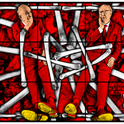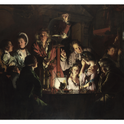F Scott Fitzgerald was fulsome in his praise and Sinclair Lewis declared it the “first book to catch Manhattan”. Published a few months after Fitzgerald’s The Great Gatsby, John Dos Passos’s novel Manhattan Transfer was the other great American novel of 1925, but as Gatsby continues to be lionised, analysed and republished—and adapted for film and the musical stage—Dos Passos’s book remains a niche concern. Routinely referred to as Manhattan’s Ulysses moment, the scalpel it took to the American Dream was as sharp as Fitzgerald’s—indeed Jay Gatsby himself could easily be dropped into Manhattan Transfer’s unfolding labyrinth without standing out unduly.
Chicago-born Dos Passos was in France when Manhattan Transfer was published and found himself as amazed as anyone else when a batch of glowing reviews arrived in the mail from his publisher—his working assumption was that his new novel would flop, like his earlier books. While sailing home to New York after an earlier French trip, he read Joyce’s Ulysses and, an inveterate American in Paris, the art he had already encountered in the city helped confirm for him that literature could also be fashioned as a mosaic.
He had helped paint the stage sets for Igor Stravinsky’s mosaic-panelled ballet Les Noces, premiered by Sergei Diaghilev’s Ballet Russe company in 1923, and walked around the party held to celebrate the production, with a guestlist including Picasso, Stravinsky and Jean Cocteau, in awe. That same summer, he also involved himself in a new ballet double-bill: Darius Milhaud’s jazz ballet La Création du monde paired with Cole Porter’s only ballet, Within the Quota. Although Dos Passos returned to New York before its premiere, Porter’s scenario—a stranger arrives in New York for the first time and attempts to acclimatise themselves to the information overload of urban sights, smells and noises—chimed with the novel he was already dreaming up.
Back in the US, Dos Passos took himself off to a boarding-house on Long Island to work on the novel that became Manhattan Transfer, for much the same reason that Scott and Zelda Fitzgerald moved there around the same time: to find space away from the city to think. In her introduction to Cambridge University Press’s centennial edition of The Great Gatsby, published earlier this year, Sarah Churchwell described how the “restrained extravagance” of its prose emerged out of the contrast between the “modern jazz of its setting and formal romanticism of Fitzgerald’s style”. No such restraint around Manhattan Transfer: this novel speeds away in a thousand directions at once—not so much modern jazz, as a free improvisation sprawling over nearly 400 pages.
It was, by design, a novel without a centre. The character Dos Passos introduced on its opening page, Bud Korpenning, on the run from the police, has crossed into Manhattan by ferry from New Jersey, and Dos Passos handed him a catchphrase that would punctuate every subsequent appearance: “How do I get to Broadway?... I want to get to the center of things.” But in New York there can never be any centre of activity; too many people, packed into a compressed land mass, are involved in too many activities. The clue to how Dos Passos found a literary form without centre lies in his title, which prepares the reader for a structure in which characters criss-cross and individual stories intersect, like trains switched in other directions by track points. (The Manhattan Transfer station in New Jersey was where train lines heading into Manhattan met, where passengers could transfer from one train to another.)
The book’s title prepares the reader for a structure in which characters criss-cross and individual stories intersect
Docking in the harbour two chapters later: the young Jimmy Herf and his mother, arriving from Europe. Dos Passos will trace Jimmy’s story through childhood and adolescence into his adult life, his transformation defined entirely by the city. Introduced later is Ellen, whose first husband John proves himself a simpering dullard. Ellen escapes the tedium of her marriage—strong proto-Marvelous Mrs Maisel vibes here—by taking a room of her own at a hotel. When she pairs off with Jimmy, though, the mood quickly sours. Jimmy has become a newspaper journalist, desperately scouring the city for the next story. Which is disappointing to Ellen, who holds his blinkered ambition in disdain. He reports on the influential and rich; Ellen wants to be rich and casts him aside.
Dos Passos sews their narrative into a patchwork structure, which elsewhere concerns itself with such hot potatoes as union politics and theatreland. In a scene from his second chapter, “Metropolis”, set in a fancy restaurant, seven characters are let loose and left to coexist—without necessarily interacting—in the same space. Dos Passos captures the totality of that moment by isolating the layers of conversation, without trying to make narrative sense of them. In life, conversations are jumbled, digressive and constantly switch direction—again, like the points of a railway.
Ultimately, the main character of Manhattan Transfer was the city itself, while its distinctive soundscape told Dos Passos how he should orchestrate conversation and speech. Many affairs later, Ellen has become engaged to a cash-rich lawyer, and Dos Passos mutates her into a dehumanised, hard-hearted robot—“an intricate machine of sawtooth steel whitebright bluebright cooperbright”—a person consumed by the systemic greed of the city. As she and her new lover are driven away in a cab and start to kiss, Ellen evaporates into “whirling faces, streetlights, zooming nickleglinting wheels”.
Ellen’s journey from her carefree, contented childhood to being sucked inside a dark distortion of the idealistic American Dream, revealed Dos Passos’s ambivalence about his city. He was uplifted by New York, inspired by energy that he described elsewhere as quivering like “a badly drawn cartoon”. Yet his awareness that the good times for people at the top meant that others were inevitably crushed underfoot nagged at his conscience. An admirer of TS Eliot, he wrote of how New Yorkers “swarm meekly like ants along designated routes, crushed by the disdainful and pitiless things around them”.
But New York was his waste land of choice, and the tension between the fantasy of Dos Passos’s improvisational style and the immediacy of his newsreel-like reportage handed Manhattan Transfer its momentum. As a young writer grappling to find his voice, his most immediate task was to make sense of New York City.













